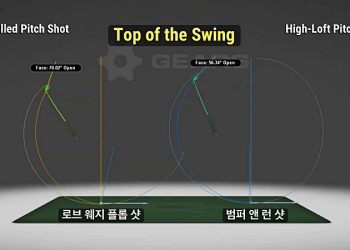주말 골퍼들이 완벽한 회전의 백스윙을 만들기는 쉽지 않다. 충분히 몸의 회전이 되지 않은 백스윙은 모든 문제의 원인을 제공한다. 당장 클럽 패스의 인투아웃 스윙을 진행하기 어렵다.
백스윙이 충분치 않은 골퍼들은 드라이버샷의 볼 스핀량도 과도하게 증가할 수 있다. 드라이버샷의 적당한 볼 스핀은 2700rpm이다. 즉 1분당 2700번의 볼 회전이 비거리를 만들어 내는 데 좋다는 뜻이다. 백스윙이 충분치 않으면 드라이버샷 스핀량이 4700rpm까지 올라간다. 1000rpm당 15야드의 거리 손실이 있다.
스윙의 적절한 타이밍을 지키기도 쉽지 않다. 근본적으로 백스윙이 어려운 이유는 몸의 유연성과 연관이 있다. 이러한 문제점을 애니카 소렌스탐의 백스윙 방법과 트랜지션을 통해 알아본다.
아마추어 골퍼들은 드라이버샷의 스윙 리듬을 잘 지키기 어렵다. 긴 클럽을 사용할 때는 스윙을 급하게 하려는 생각 때문에 더 어렵다. 그립도 아이언샷보다 더 강하게 잡는다. 빠른 백스윙은 몸을 이용하는 스윙보다는 팔 위주의 스윙을 하게 된다.
드라이버샷을 할 때 팔로만 급하게 들어 올리면 임팩트 순간에 클럽의 어택 앵글은 내려치는 각도로 나타난다. 볼은 깎이게 되고 방향과 비거리를 순식간에 잃게 된다. 애니카는 드라이버샷을 할 때도 웨지를 치는 것처럼 몸 전체를 사용해서 스윙한다. 팔로만 들었다 치는 드라이버샷을 피하기 위해서다.
또 하나 드라이버샷에서 집중해야 할 부분은 하체의 움직임이다. 안정된 하체는 스윙의 기본이 되는 어드레스 자세를 만든다. 연속성을 요구하는 스윙에서 스윙의 전체적인 흐름을 만들어 준다. 또한 방향성을 높이는 피니시 자세를 쉽게 해준다.
애니카는 몸을 완전히 꼬았다가 빠르게 풀어내는 백스윙을 한다. 마치 고무밴드를 강하게 꼬았다가 순간에 놓아주면 빠르게 반대로 풀리는 원리를 적용하는 것이다.
스탠스의 폭도 넓고 견고하다. 그리고 탑에서 중요한 포인트는 어깨와 그립을 잡은 양손 사이에 충분한 공간을 유지하는 것이다. 이러한 동작은 간결한 스윙의 근본이 된다. 간결하다는 뜻은 왼쪽 어깨를 작게 회전하라는 뜻은 아니다. 어깨의 회전은 충분히 하되, 양손과 어깨의 공간을 유지하라는 뜻이다.
탑에서 임팩트까지 걸리는 시간은 0.2초 전후의 순간이다. 탑의 동작이 커지면 이러한 타이밍을 만들기 어렵다. 팔로만 백스윙을 하면 상·하체의 회전이 작아진다. 결과적으로 양손과 어깨 사이에 간격도 좁게 된다.
다운스윙이 준비된 백스윙의 탑은 왼쪽 어깨가 자신의 턱 아래에 놓이게 될 때이다. 다운스윙에서는 하체인 엉덩이와 어깨가 순서에 따라 내려온다. 마지막으로 손과 클럽헤드가 내려오게 된다. 백스윙에서 진행된 클럽헤드→어깨→엉덩이 순서와 정반대인 셈이다.
다운스윙이 하체로 이동하게 되면 클럽이 덜 풀리게 되어 가파르게 끌고 내려올 수 있다. 이때 이 각도를 최대한 유지하게 되면 임팩트 순간에 헤드 스피드를 빠르게 할 수 있다. 드라이버샷 비거리를 만들기 위한 비밀은 바로 이 순간에 있다.
☞ 전욱휴는…
골프 칼럼니스트. PGA 클래스A 멤버이자 공인 티칭 및 코칭 강사다. SBS, MBC, JTBC, YTN 등의 골프 채널에서 진행자 및 해설자로 활약했다. 현재 애틀랜타에서 골프 레슨 및 골프 관련 비즈니스를 하고 있다. chungolf@gmail.com
“Dr.Eric Chun’s PGA Golf Lesson 6. Sorenstam’s Driver Shot 2
“When the left shoulder touches under the chin, the backswing top is complete.”
“You must create enough space between both hands and the shoulders at the top.”
Many weekend golfers find it difficult to create a perfect backswing rotation. A backswing without enough body rotation is the cause of all problems. It makes it difficult to proceed with an in-to-out club path swing right away. Golfers with insufficient backswings can also see an excessive increase in the spin rate of their driver shots. The appropriate spin rate for a driver shot is 2,700rpm. In other words, a ball rotation of 2,700 times per minute is good for creating distance. Golfers with insufficient backswings can see the spin rate go up to 4,700rpm. There is a distance loss of 15 yards per 1,000rpm. It is also not easy to maintain the proper timing of the swing. Fundamentally, the difficulty of the backswing is associated with body flexibility. We will explore this issue through Annika’s backswing method and transition.
Amateur golfers, who relatively practice less, find it difficult to maintain the swing rhythm of the driver shot. When using a long club, the thought of making a quick swing makes it even more difficult to maintain rhythm. For these reasons, they grip the club more strongly than they do for iron shots. A quick backswing results in a swing that uses the arms more than the body. Annika swings using her entire body even when making a driver shot, just as she would swing a wedge. This is to avoid hurriedly lifting and hitting with just the arms. When lifting quickly with just the arms during a driver shot, the club’s attack angle at the moment of impact appears to be a downward angle. The ball is sliced, and direction and distance are lost instantly. And the most critical part to focus on during a driver shot is the movement of the lower body. A stable lower body creates the basic address posture for the swing. It creates the overall flow of the swing that requires continuity. And it easily allows for a finish posture that enhances directionality.
Annika performs a backswing motion using her entire body.
She applies the principle of completely twisting the body and then quickly releasing it. Just as if a rubber band is strongly twisted and then released, it unwinds quickly in the opposite direction, she applies this principle when hitting the ball with a driver shot. In other words, she applies the principle of completely rotating the backswing motion and then releasing the stored twist force as acceleration when hitting the ball. The width of the stance is also made wide and firm. The whole body is used during the backswing. The body rotation is used to proceed up to the top of the backswing. And the important point at the top is to maintain enough space between the shoulders and the hands gripping the club. This action becomes the foundation of a concise swing. Being concise does not mean to rotate the left shoulder minimally. It means to sufficiently rotate the shoulder but maintain the space between the hands and the shoulder. The time it takes from the top to the impact is momentary. When converted into time, it appears around 0.20 seconds. It becomes difficult to create such timing as the action at the top becomes bigger. Relatively more training for the body also occurs. If you backswing with just the arms, the rotation of the upper and lower body decreases. Consequently, the gap between both hands and the shoulders narrows. The top of the backswing, prepared for the downswing, is when the left shoulder is placed under the chin. In the downswing, the lower body, hips, shoulders come down in order. Lastly, the hands and clubhead come down. It is the opposite order of the clubhead, shoulders, hips in the backswing. When the downswing moves to the lower body, the club is less released and can be pulled down sharply. If this angle is maintained as much as possible, the head speed can be fastened at the moment of impact.
The secret to creating distance in a driver shot is precisely at this moment.”





![[전욱휴의 골프레슨] 6. 소렌스탐 드라이버샷 2](https://www.atlantajoongang.com/wp-content/uploads/2024/05/collage-2-750x656.jpg)













![[전욱휴의 골프 레슨] 46. 배치기(얼리 익스텐션)](https://www.atlantajoongang.com/wp-content/uploads/2025/03/photoKakaoTalk_20250306_073237889_01-350x250.jpg?v=1741361116)
![[전욱휴의 골프 레슨] 45. 임성재 '행온페이드' 샷](https://www.atlantajoongang.com/wp-content/uploads/2025/02/collage1-350x250.jpg)
![[전욱휴의 골프레슨] 44. 일관된 샷을 원한다면](https://www.atlantajoongang.com/wp-content/uploads/2025/02/QKakaoTalk_20250212_065748485-350x250.jpg)

![[전욱휴 골프 레슨] 42. 오른쪽 팔꿈치 역할](https://www.atlantajoongang.com/wp-content/uploads/2025/01/qQ1KakaoTalk_20250130_072058648-350x250.jpg)
![[전욱휴의 골프 레슨] 41. 매킬로이 파워 스윙](https://www.atlantajoongang.com/wp-content/uploads/2025/01/qQ1KakaoTalk_20250122_123635940-350x250.jpg)







